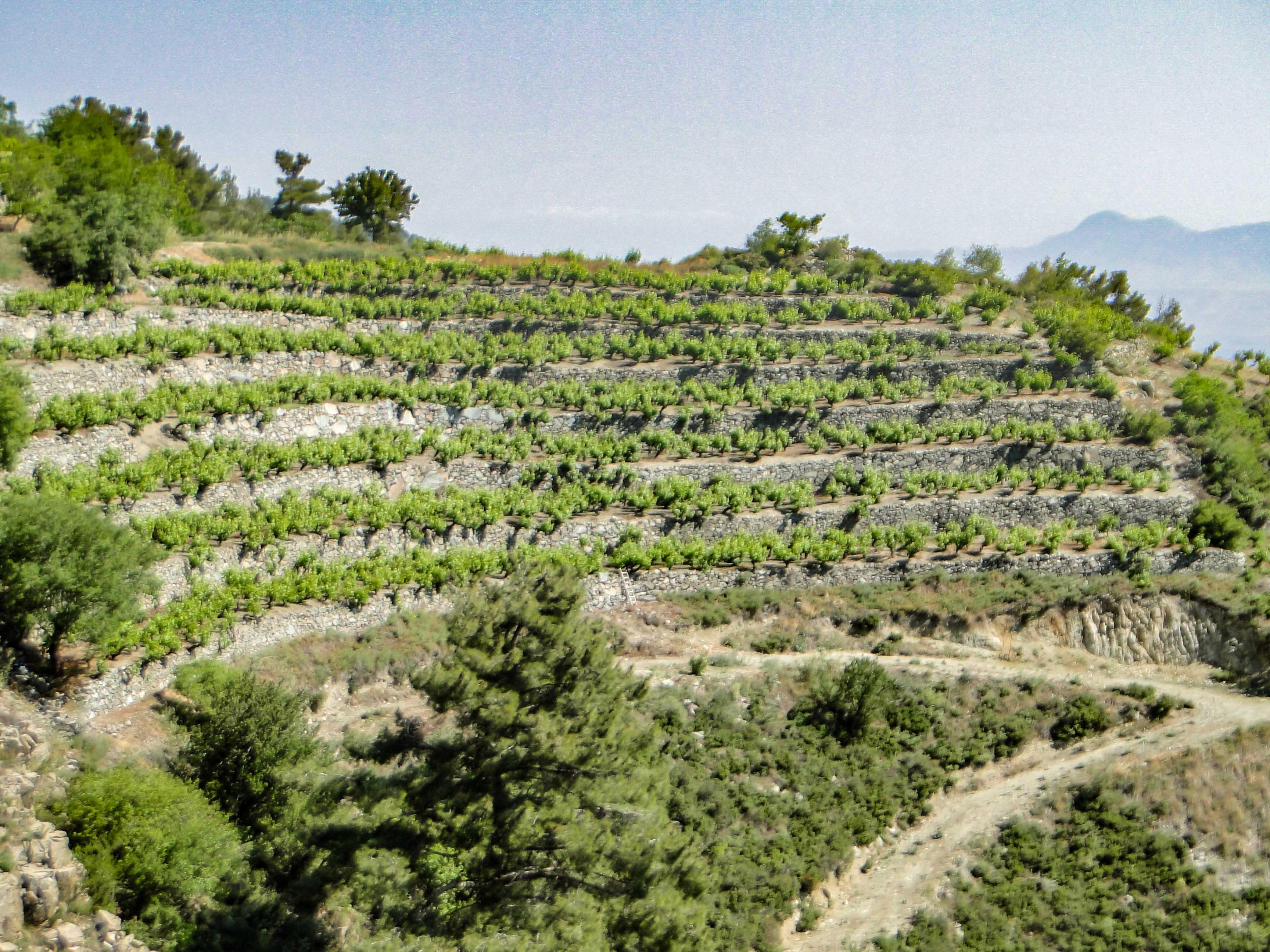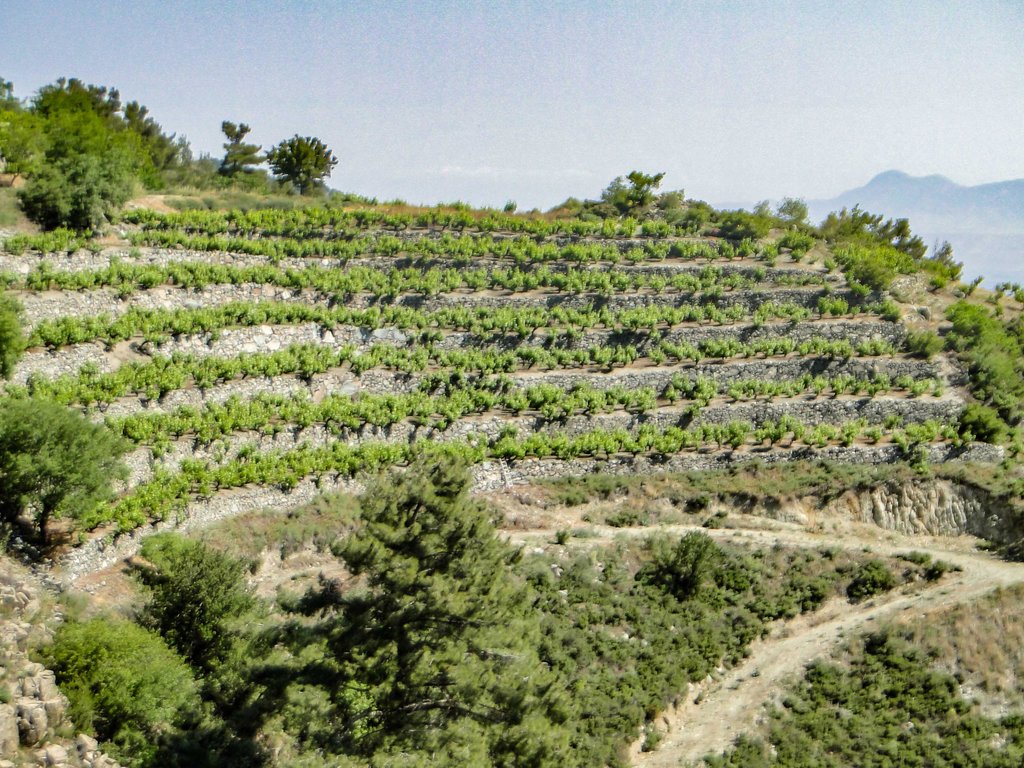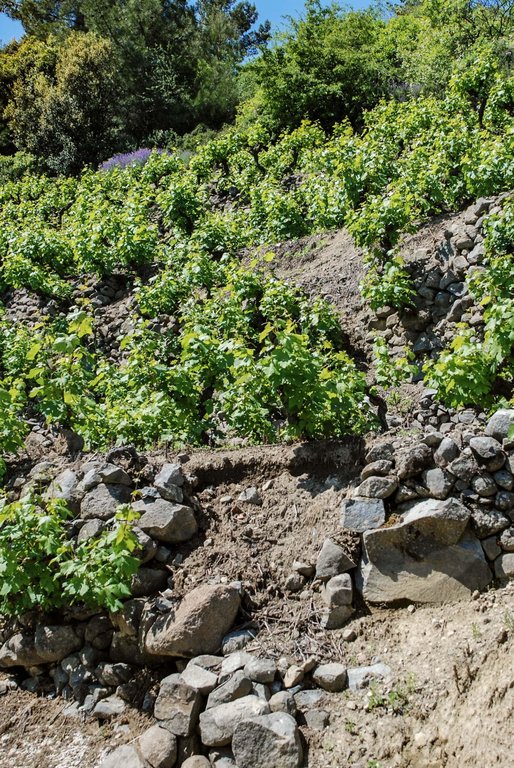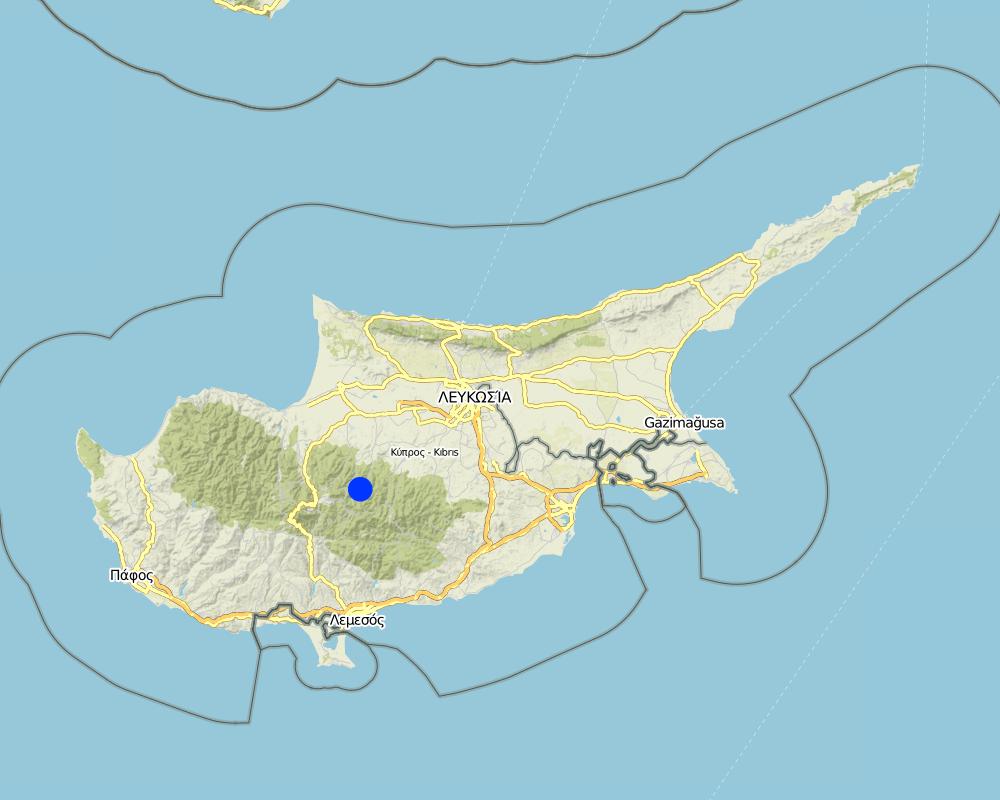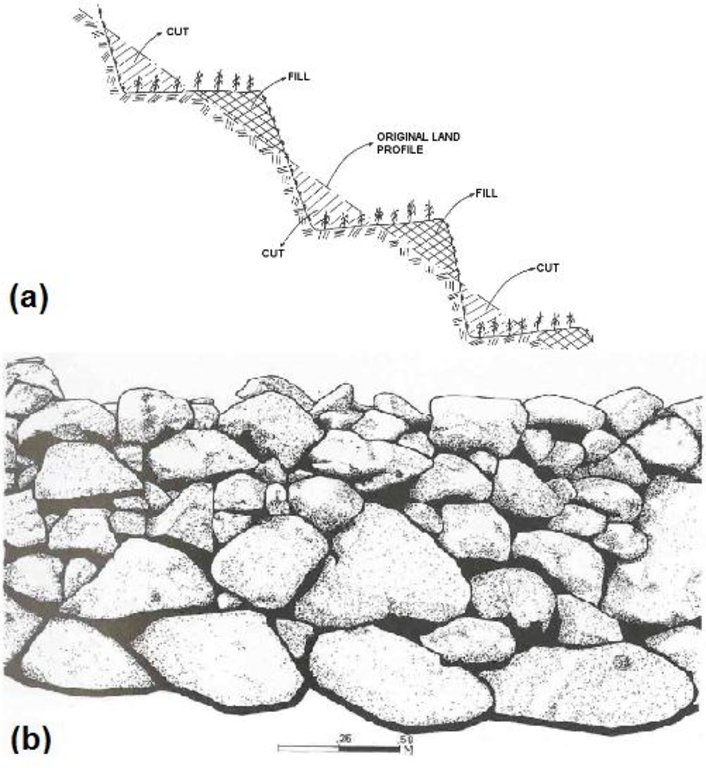Agricultural terraces with dry-stone walls [ไซปรัส]
- ผู้สร้างสรรค์:
- การอัพเดท:
- ผู้รวบรวม: Christos Zoumides
- ผู้เรียบเรียง: –
- ผู้ตรวจสอบ: Deborah Niggli, Alexandra Gavilano
Γεωργικές αναβαθμίδες με τοίχους ξερολιθιάς (Greek)
technologies_1702 - ไซปรัส
ดูส่วนย่อย
ขยายทั้งหมด ย่อทั้งหมด1. ข้อมูลทั่วไป
1.2 รายละเอียดที่ติดต่อได้ของผู้รวบรวมและองค์กรที่เกี่ยวข้องในการประเมินและการจัดเตรียมทำเอกสารของเทคโนโลยี
ผู้เชี่ยวชาญ SLM:
Bruggeman Adriana
The Cyprus Institute
ไซปรัส
ผู้เชี่ยวชาญ SLM:
Camera Corrado
The Cyprus Insitute
ไซปรัส
ชื่อของโครงการซึ่งอำนวยความสะดวกในการทำเอกสารหรือการประเมินเทคโนโลยี (ถ้าเกี่ยวข้อง)
Preventing and Remediating degradation of soils in Europe through Land Care (EU-RECARE )ชื่อขององค์กรซึ่งอำนวยความสะดวกในการทำเอกสารหรือการประเมินเทคโนโลยี (ถ้าเกี่ยวข้อง)
The Cyprus Institute (The Cyprus Institute) - ไซปรัส1.3 เงื่อนไขการใช้ข้อมูลที่ได้บันทึกผ่านทาง WOCAT
ผู้รวบรวมและวิทยากรหลักยอมรับเงื่อนไขเกี่ยวกับการใช้ข้อมูลที่ถูกบันทึกผ่านทาง WOCAT:
ใช่
1.4 การเปิดเผยเรื่องความยั่งยืนของเทคโนโลยีที่ได้อธิบายไว้
เทคโนโลยีที่ได้อธิบายไว้นี้เป็นปัญหาของความเสื่อมโทรมโทรมของที่ดินหรือไม่ จึงไม่ได้รับการยอมรับว่าเป็นเทคโนโลยีเพื่อการจัดการที่ดินอย่างยั่งยืน:
ไม่ใช่
1.5 Reference to Questionnaire(s) on SLM Approaches (documented using WOCAT)
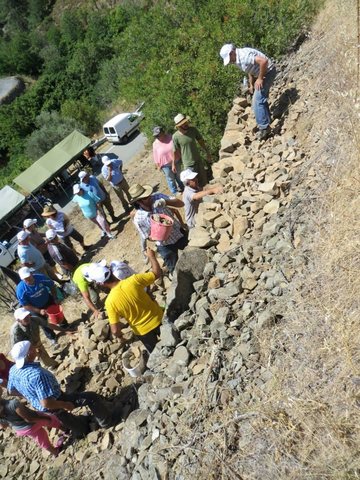
Community-based maintenance and rehabilitation of agricultural terraces in … [ไซปรัส]
Maintenance and rehabilitation of traditional dry-stone terrace walls for agricultural use, through science-society cooperation, community engagement and motivation, and assistance to land users.
- ผู้รวบรวม: Christos Zoumides
2. การอธิบายลักษณะของเทคโนโลยี SLM
2.1 การอธิบายแบบสั้น ๆ ของเทคโนโลยี
คำจำกัดความของเทคโนโลยี:
Dry-stone terraces built to create agricultural land, minimise soil erosion and retain soil moisture on steep mountain slopes.
2.2 การอธิบายแบบละเอียดของเทคโนโลยี
คำอธิบาย:
Dry-stone terraces consist of a series of nearly levelled platforms built along contour lines at suitable intervals. These structures characterise a large part of the landscape in Cyprus, and especially in communities around Troodos Mountains where large areas have been converted to agricultural terraces. The typical terraces found in the study-area are narrow (1-3 m) to medium-base (3-6 m) bench terraces, constructed by cutting and filling in slopes between 20-40%. The terraces are supported by walls, whereby stone is the only construction material without any binding mortar.
Terracing is one of the oldest means of cultivating slopes while saving soil and water. Due to the steep terrain of Troodos Mountains, the establishment of terraces acts as sediment trap storing the washed-off soil material within the slope. In general, terraces were created to stop or reduce the degrading effect of soil erosion by intercepting and controlling the surface run-off velocity and by facilitating its slower infiltration. In such a way, the sediment that accumulates behind the terraces has created suitable land for farming. In addition, the construction of dry-stone walls serves a dual purpose: to clear the land from large rock and stones, and to enhance the stability of the bench terraces against loss of top-soil. This is a type of technology that was very much used in the past and seen today as an important cultural landscape and heritage for these communities.
The construction of dry-stone walls was usually completed by the family who owned the field. Men undertook the building while the rest of the family carried the stones; assistance was also offered by relatives and friends of the family. First, the topography, the height and shape of the terrace is evaluated. Using a fuse, the craftsman shapes a straight line which would follow while building the wall. The foundations are created by excavating a pit of ~0.3-0.5 m, depending on the type of soils and the size of the wall; fuse, pick, mattock and shovel are the typical tools used. The pit is filled with large, irregular-shaped stones.
The stones are used in their natural shape for the construction of the walls without any processing. They are separated according to their shape, size and texture. The stones usually come from the cleaning of fields which will be cultivated or from a small-scale quarrying of the mountain slope using pick and lever. Large and irregular stones are used for the foundations, and the more regular ones for the construction of walls. The smaller stones are placed in between the large stones as the linchpin, to provide better stability to the structure.
The wall follows the land inclination and is laid over the foundation. Large stones are placed on the lower courses of the wall and on the exterior side. The stones are placed by hand one over the other, while smaller stones and rubbles are put between them in order to achieve more stability and better positioning; the stones cross both vertically and horizontally in order to avoid the creation of columns which will make the structure less stable. The wall is built lengthwise following the foundations and it reclines inwards; declination from the foundations does not exceed 5%. The back side of the wall is filled-up with more irregular stones which are not suitable to be placed on the front side. The filling connects the wall with the soil and stabilises the structure, and allows the drainage of water that is collected from the terrace and is discharged through the stones of the wall.
Terrace farming of grapes, nut and fruit trees, along with natural (mainly sclerophylous) vegetation constitute the predominant land uses in this area. The total population in the eight mountain communities of Peristerona Watershed has decreased by more than 50% over the past 30 years. The depopulation of mountain communities is associated with the urbanisation trends and the high farming costs which led to the gradual reduction of agricultural activities in the area. These socio-economic attributes form the main constraining factors for soil conservation. Thus, although terraces have a particularly beneficial effect in maintaining the productive capacity of soils in these communities, the significant changes in the socio-economic structure of the agricultural population over the last decades and the high maintenance and labour required, has led farmers to gradually abandon terrace farming. Consequently, many of the mountain terraces are no longer cultivated and dry stone walls are not maintained, causing sometimes a domino effect of collapsing terraces.
2.3 รูปภาพของเทคโนโลยี
2.5 ประเทศภูมิภาค หรือสถานที่ตั้งที่เทคโนโลยีได้นำไปใช้และได้รับการครอบคลุมโดยการประเมินนี้
ประเทศ:
ไซปรัส
ภูมิภาค/รัฐ/จังหวัด:
Nicosia
ข้อมูลจำเพาะเพิ่มเติมของสถานที่ตั้ง :
Northeast Pitsilia
ระบุการกระจายตัวของเทคโนโลยี:
- กระจายไปอย่างสม่ำเสมอในพื้นที่
If the Technology is evenly spread over an area, specify area covered (in km2):
30.9
If precise area is not known, indicate approximate area covered:
- 10-100 ตร.กม.
แสดงความคิดเห็น:
Total area covered by the SLM Technology is 30.9 km2.
Dry-stone terraces characterise a large part of the landscape in Cyprus, and especially in communities around Troodos Mountains. There is a large variety of dry-stone terraces on the island, according to the morphology of each area and the accessibility to raw materials. The information reported here refer to the mountain communities in Northeast Pitsilia and particularly to the Peristerona watershed upstream communities (RECARE project case-study site).
Map
×2.6 วันที่การดำเนินการ
ถ้าไม่รู้ปีที่แน่นอน ให้ระบุวันที่โดยประมาณ:
- มากกว่า 50 ปี (แบบดั้งเดิม)
2.7 คำแนะนำของเทคโนโลยี
ให้ระบุว่าเทคโนโลยีถูกแนะนำเข้ามาอย่างไร:
- เป็นส่วนหนึ่งของระบบแบบดั้งเดิมที่ทำก้นอยู่ (> 50 ปี)
ความคิดเห็น (ประเภทของโครงการ เป็นต้น) :
Dry-stone terracing has been practice for centuries in Cyprus and in the study area. The rehabilitation of dry-stone terraces through community-based activities has been introduced in 2015 by the RECARE project case-study team and the local communities.
3. การจัดประเภทของเทคโนโลยี SLM
3.1 วัตถุประสงค์หลักของเทคโนโลยี
- ลด ป้องกัน ฟื้นฟู การเสื่อมโทรมของที่ดิน
3.2 ประเภทของการใช้ที่ดินในปัจจุบันที่ได้นำเทคโนโลยีไปใช้

พื้นที่ปลูกพืช
- การปลูกไม้ยืนต้น ไม้พุ่ม
Tree and shrub cropping - Specify crops:
- fruits, other
- grapes
- tree nuts (brazil nuts, pistachio, walnuts, almonds, etc.)
จำนวนของฤดูเพาะปลูกต่อปี:
- 1
ระบุ:
Longest growing period in days: 240, Longest growing period from month to month: Mid March to early November (grapevines)
แสดงความคิดเห็น:
Major land use problems (compiler’s opinion): Soil erosion by water from degraded and collapsing dry-stone terraces.
Loss of productive capacity.
Major land use problems (land users’ perception): Gradual collapse of dry-stone walls.
Root rot and yield failure as a result of water-logging which is linked to poor drainage in terraced fields.
3.4 การใช้น้ำ
การใช้น้ำของที่ดินที่มีการใช้เทคโนโลยีอยู่:
- จากน้ำฝน
3.5 กลุ่ม SLM ที่ตรงกับเทคโนโลยีนี้
- มาตรการปลูกพืชขวางความลาดชัน (cross-slope measure)
3.6 มาตรการ SLM ที่ประกอบกันเป็นเทคโนโลยี

มาตรการอนุรักษ์ด้วยโครงสร้าง
- S1: คันดิน
แสดงความคิดเห็น:
Main measures: structural measures
3.7 รูปแบบหลักของการเสื่อมโทรมของที่ดินที่ได้รับการแก้ไขโดยเทคโนโลยี

การกัดกร่อนของดินโดยน้ำ
- Wt (Loss of topsoil): การสูญเสียดินชั้นบนหรือการกัดกร่อนที่ผิวดิน
- Wo (Offsite degradation): ผลกระทบนอกพื้นที่
แสดงความคิดเห็น:
Main type of degradation addressed: Wt: loss of topsoil / surface erosion
Secondary types of degradation addressed: Wo: offsite degradation effects
Main causes of degradation: other human induced causes (specify) (Gradual abandonment of mountain agriculture), other natural causes (avalanches, volcanic eruptions, mud flows, highly susceptible natural resources, extreme topography, etc.) specify (Steep mountain terrain)
Secondary causes of degradation: land tenure (Small, fractured agricultural plots), governance / institutional (Lack of institutions for terrace maintenance)
3.8 การป้องกัน การลดลง หรือการฟื้นฟูความเสื่อมโทรมของที่ดิน
ระบุเป้าหมายของเทคโนโลยีกับความเสื่อมโทรมของที่ดิน:
- ป้องกันความเสื่อมโทรมของที่ดิน
- ฟื้นฟูบำบัดที่ดินที่เสื่อมโทรมลงอย่างมาก
4. ข้อมูลจำเพาะด้านเทคนิค กิจกรรมการนำไปปฏิบัติใช้ ปัจจัยนำเข้า และค่าใช้จ่าย
4.1 แบบแปลนทางเทคนิคของเทคโนโลยี
ข้อมูลจำเพาะด้านเทคนิค (แบบแปลนทางเทคนิคของเทคโนโลยี):
(a) The typical terraces found in the study-area are narrow (1-3 m) to medium-base (3-6 m) bench terraces, constructed by cutting and filling in slopes between 20-40%. The height of terraces range between 0.75 to 2 meters, depending on the steepness and the morphology of each slope.
(b) The terraces are supported by walls, whereby stone - typically volcanic rock - is the only construction material without any binding mortar. Large and irregular stones are used for the foundations, while the more regular for the construction of walls. The smaller stones are placed in between the large stones as the linchpin, to provide better stability to the structure. The wall is built lengthwise following the foundations and it reclines inwards; declination from the foundations does not exceed 5%. The back side of the wall is filled-up with more irregular stones which are not suitable to be placed on the front side. The filling connects the wall with the soil and stabilises the structure, and allows the drainage of water that is collected from the terrace and is discharged through the stones of the wall.
Northeast Pitsilia, Nicosia
Technical knowledge required for land users: moderate (To maintain dry-stone wall terraces)
Technical knowledge required for Dry-stone artisans (experts builders): high (To reconstruct collapsed terraces)
Main technical functions: reduction of slope angle, sediment retention / trapping, sediment harvesting
Secondary technical functions: increase of infiltration, increase / maintain water stored in soil
Terrace: bench level
Vertical interval between structures (m): 1-2
Spacing between structures (m): 1-15
Construction material (stone): Natural volcanic rock available on the sites (mostly gabbro & diabase)
Lateral gradient along the structure: 0-8%
ผู้เขียน:
a: FAO, 2000 & b: TPH, 2007
4.2 ข้อมูลทั่วไปเกี่ยวกับการคำนวณปัจจัยนำเข้าและค่าใช้จ่าย
อื่นๆ หรือสกุลเงินประจำชาติ (ระบุ):
Euro
If relevant, indicate exchange rate from USD to local currency (e.g. 1 USD = 79.9 Brazilian Real): 1 USD =:
0.88
ระบุค่าเฉลี่ยของค่าจ้างในการจ้างแรงงานต่อวัน:
72.97
4.3 กิจกรรมเพื่อการจัดตั้ง
| กิจกรรม | Timing (season) | |
|---|---|---|
| 1. | Land leveling and foundation | Early autumn or late spring |
| 2. | Collection and transfer of stones | Early autumn or late spring |
| 3. | Construction of stone-wall | Early autumn or late spring |
4.4 ค่าใช้จ่ายของปัจจัยนำเข้าที่จำเป็นสำหรับการจัดตั้ง
| ปัจจัยนำเข้า | หน่วย | ปริมาณ | ค่าใช้จ่ายต่อหน่วย | ค่าใช้จ่ายทั้งหมดต่อปัจจัยนำเข้า | %ของค่าใช้จ่ายที่ก่อให้เกิดขึ้นโดยผู้ใช้ที่ดิน | |
|---|---|---|---|---|---|---|
| แรงงาน | Labour | 4000.0 | 45.6 | 182400.0 | 100.0 | |
| ค่าใช้จ่ายทั้งหมดของการจัดตั้งเทคโนโลยี | 182400.0 | |||||
| Total costs for establishment of the Technology in USD | 207272.73 | |||||
แสดงความคิดเห็น:
Duration of establishment phase: 83 month(s)
4.5 การบำรุงรักษาสภาพหรือกิจกรรมที่เกิดขึ้นเป็นประจำ
| กิจกรรม | ช่วงระยะเวลา/ความถี่ | |
|---|---|---|
| 1. | Repairing collapsed walls | Early autumn (before onset of rains), only on collapsed walls |
4.6 ค่าใช้จ่ายของปัจจัยนำเข้าและกิจกรรมที่เกิดขึ้นเป็นประจำที่ต้องการการบำรุงรักษา (ต่อปี)
| ปัจจัยนำเข้า | หน่วย | ปริมาณ | ค่าใช้จ่ายต่อหน่วย | ค่าใช้จ่ายทั้งหมดต่อปัจจัยนำเข้า | %ของค่าใช้จ่ายที่ก่อให้เกิดขึ้นโดยผู้ใช้ที่ดิน | |
|---|---|---|---|---|---|---|
| แรงงาน | Labour | 200.0 | 9.12 | 1824.0 | 100.0 | |
| ค่าใช้จ่ายทั้งหมดของการบำรุงรักษาสภาพเทคโนโลยี | 1824.0 | |||||
| Total costs for maintenance of the Technology in USD | 2072.73 | |||||
แสดงความคิดเห็น:
Machinery/ tools: Wedge, hammer, pick, hoe and bucket are the typical tools used for by stone builders for the construction and maintenance of dry-stone terraces.
The costs estimates are averages and were calculated for the length of terrace structures, i.e. per running meter of terrace walls. The average height of dry-stone walls is 1.5 meter and it takes approximately 5 hours/meter for a builder to fully construct it. This includes 1 hour/meter for land levelling and foundation, 1 hour/meter for the collection and transfer of the necessary stones and 3 hours/meter for building the wall. Stones are abundant in the area; builders do not charge for the stones but for the time required to collect and transfer. Also, each builder has its own tools (i.e. wedge, hammer, pick, hoe and bucket). Terrace builders charge 8 €/hour (or 9.12 $/hour). On average, there are approximately 4000 running meters of terrace walls per hectare. The above information is used to convert the construction cost per hectare.
Maintenance activities include reconstruction of the terrace walls, only in case of collapsing. The reconstruction takes 1 hour/meter. For the annual maintenance estimates, it is assumed that 200 out of 4000 meters of terrace walls per hectare (or 5%) will require maintenance. In other words, a newly constructed wall will be maintained once every 20 years, on average.
4.7 ปัจจัยสำคัญที่สุดที่มีผลกระทบต่อค่าใช้จ่าย
ปัจจัยสำคัญที่สุดที่มีผลกระทบต่อค่าใช้จ่ายต่างๆ:
The principal input cost for the construction and maintenance of terraces is manual labour. There are only few dry-stone builders in the area.
5. สิ่งแวดล้อมทางธรรมชาติและของมนุษย์
5.1 ภูมิอากาศ
ฝนประจำปี
- < 250 ม.ม.
- 251-500 ม.ม.
- 501-750 ม.ม.
- 751-1,000 ม.ม.
- 1,001-1,500 ม.ม.
- 1,501-2,000 ม.ม.
- 2,001-3,000 ม.ม.
- 3,001-4,000 ม.ม.
- > 4,000 ม.ม.
ข้อมูลจำเพาะ/ความคิดเห็นเรื่องปริมาณน้ำฝน:
500-750mm: Seasonal rainfall (October to May) - Peristerona watershed upstream
250-500mm: Seasonal rainfall (October to May) - Peristerona watershed downstream
เขตภูมิอากาศเกษตร
- กึ่งชุ่มชื้น
- กึ่งแห้งแล้ง
Thermal climate class: subtropics. Below 1000m a.s.l.
Thermal climate class: temperate. Above 1000m a.s.l.
5.2 สภาพภูมิประเทศ
ค่าเฉลี่ยความลาดชัน:
- ราบเรียบ (0-2%)
- ลาดที่ไม่ชัน (3-5%)
- ปานกลาง (6-10%)
- เป็นลูกคลื่น (11-15%)
- เป็นเนิน (16-30%)
- ชัน (31-60%)
- ชันมาก (>60%)
ธรณีสัณฐาน:
- ที่ราบสูง/ที่ราบ
- สันเขา
- ไหล่เขา
- ไหล่เนินเขา
- ตีนเนิน
- หุบเขา
ระดับความสูง:
- 0-100 เมตร
- 101-500 เมตร
- 501-1,000 เมตร
- 1,001-1,500 เมตร
- 1,501-2,000 เมตร
- 2,001-2,500 เมตร
- 2,501-3,000 เมตร
- 3,001-4,000 เมตร
- > 4,000 เมตร
ให้ระบุถ้าเทคโนโลยีได้ถูกนำไปใช้:
- ไม่เกี่ยวข้อง
5.3 ดิน
ค่าเฉลี่ยความลึกของดิน:
- ตื้นมาก (0-20 ซ.ม.)
- ตื้น (21-50 ซ.ม.)
- ลึกปานกลาง (51-80 ซ.ม.)
- ลึก (81-120 ซ.ม.)
- ลึกมาก (>120 ซ.ม.)
เนื้อดิน (ดินชั้นบน):
- หยาบ/เบา (ดินทราย)
- ปานกลาง (ดินร่วน ทรายแป้ง)
อินทรียวัตถุในดิน:
- ปานกลาง (1-3%)
- ต่ำ (<1%)
5.4 ความเป็นประโยชน์และคุณภาพของน้ำ
ระดับน้ำใต้ดิน:
> 50 เมตร
น้ำไหลบ่าที่ผิวดิน:
ปานกลาง
คุณภาพน้ำ (ที่ยังไม่ได้บำบัด):
เป็นน้ำเพื่อการดื่มที่ดี
5.5 ความหลากหลายทางชีวภาพ
ความหลากหลายทางชนิดพันธุ์:
- ปานกลาง
5.6 ลักษณะของผู้ใช้ที่ดินที่นำเทคโนโลยีไปปฏิบัติใช้
อยู่กับที่หรือเร่ร่อน:
- อยู่กับที่
แนวทางการตลาดของระบบการผลิต:
- mixed (subsistence/ commercial)
รายได้ที่มาจากนอกฟาร์ม:
- 10-50% ของรายได้ทั้งหมด
ระดับของความมั่งคั่งโดยเปรียบเทียบ:
- พอมีพอกิน
เป็นรายบุคคล/ครัวเรือน:
- เป็นรายบุคคล/ครัวเรือน
ระดับของการใช้เครื่องจักรกล:
- งานที่ใช้แรงกาย
- การใช้เครื่องจักรหรือเครื่องยนต์
เพศ:
- หญิง
- ชาย
ระบุลักษณะอื่นๆที่เกี่ยวข้องของผู้ใช้ที่ดิน:
Land users applying the Technology are mainly common / average land users
Population density: 10-50 persons/km2
Annual population growth: negative; 4%
100% of the land users are average wealthy.
Off-farm income specification: Farming is a part-time activity for most land users in the area.
5.7 Average area of land used by land users applying the Technology
- < 0.5 เฮกตาร์
- 0.5-1 เฮกตาร์
- 1-2 เฮกตาร์
- 2-5 เฮกตาร์
- 5-15 เฮกตาร์
- 15-50 เฮกตาร์
- 50-100 เฮกตาร์
- 100-500 เฮกตาร์
- 500-1,000 เฮกตาร์
- 1,000-10,000 เฮกตาร์
- >10,000 เฮกตาร์
พิจารณาว่าเป็นขนาดเล็ก กลาง หรือขนาดใหญ่ (ซึ่งอ้างอิงถึงบริบทระดับท้องถิ่น):
- ขนาดเล็ก
แสดงความคิดเห็น:
The average for Cyprus is 3.4 ha/holding
5.8 กรรมสิทธิ์ในที่ดิน สิทธิในการใช้ที่ดินและสิทธิในการใช้น้ำ
กรรมสิทธิ์ในที่ดิน:
- รายบุคคล ได้รับสิทธิครอบครอง
สิทธิในการใช้ที่ดิน:
- รายบุคคล
แสดงความคิดเห็น:
Agricultural land is privately owned
5.9 การเข้าถึงบริการและโครงสร้างพื้นฐาน
สุขภาพ:
- จน
- ปานกลาง
- ดี
การศึกษา:
- จน
- ปานกลาง
- ดี
ความช่วยเหลือทางด้านเทคนิค:
- จน
- ปานกลาง
- ดี
การจ้างงาน (เช่น ภายนอกฟาร์ม):
- จน
- ปานกลาง
- ดี
ตลาด:
- จน
- ปานกลาง
- ดี
พลังงาน:
- จน
- ปานกลาง
- ดี
ถนนและการขนส่ง:
- จน
- ปานกลาง
- ดี
น้ำดื่มและการสุขาภิบาล:
- จน
- ปานกลาง
- ดี
บริการด้านการเงิน:
- จน
- ปานกลาง
- ดี
6. ผลกระทบและสรุปคำบอกกล่าว
6.1 ผลกระทบในพื้นที่ดำเนินการ (On-site) จากการใช้เทคโนโลยี
ผลกระทบทางด้านเศรษฐกิจและสังคม
การผลิต
การผลิตพืชผล
แสดงความคิดเห็น/ระบุ:
Terraces create agricultural land for crop production in slopes. However, the establishment of terraces does not imply increased crop yield.
พื้นที่สำหรับการผลิต
แสดงความคิดเห็น/ระบุ:
Without terraces on mountain slopes, crop farming would have been almost impossible
ความเป็นประโยชน์และคุณภาพของน้ำ
ความต้องการน้ำจากการชลประทาน
แสดงความคิดเห็น/ระบุ:
Well constructed and maintained terraces improve water drainage and retain soil moisture.
รายได้และค่าใช้จ่าย
ค่าใช่จ่ายของปัจจัยการผลิตทางการเกษตร
แสดงความคิดเห็น/ระบุ:
More costly to grown on mountain terraces than in the plains. Also, maintenance of collapsed terrace walls is costly.
รายได้จากฟาร์ม
แสดงความคิดเห็น/ระบุ:
Farming in the study-site is practiced almost exclusively on terraces; well maintained terraces can increase farm income.
ภาระงาน
แสดงความคิดเห็น/ระบุ:
Maintenance of collapsed terrace walls requires manual labour
ผลกระทบด้านสังคมวัฒนธรรมอื่น ๆ
ความมั่นคงด้านอาหาร / พึ่งตนเองได้
แสดงความคิดเห็น/ระบุ:
Partly for those land users that still practice mountain terrace farming.
โอกาสทางวัฒนธรรม
แสดงความคิดเห็น/ระบุ:
When terraces are maintained/rehabilitated through community-based activities.
โอกาสทางด้านสันทนาการ
แสดงความคิดเห็น/ระบุ:
When terraces are maintained/rehabilitated through community-based activities.
สถาบันของชุมชน
แสดงความคิดเห็น/ระบุ:
When terraces are maintained/rehabilitated through community-based activities.
SLM หรือความรู้เรื่องความเสื่อมโทรมของที่ดิน
แสดงความคิดเห็น/ระบุ:
Dry-stone terracing is the typical soil conservation technology in the study-site
การบรรเทาความขัดแย้ง
Contribution to human well-being
แสดงความคิดเห็น/ระบุ:
Terraced landscapes in the Troodos mountains represent a longstanding tradition of self-sustained communities. In the past, terrace farming was a main activity and has contributed to the livelihoods and well-being of these communities. Nowadays, terrace farming is still practiced by much fewer land users, mainly on part-time basis.
ผลกระทบด้านนิเวศวิทยา
วัฐจักรน้ำหรือน้ำบ่า
การเก็บเกี่ยวหรือการกักเก็บน้ำ
แสดงความคิดเห็น/ระบุ:
One of the main functions of terraces.
น้ำไหลบ่าที่ผิวดิน
แสดงความคิดเห็น/ระบุ:
One of the main functions of terraces.
ดิน
สิ่งปกคลุมดิน
แสดงความคิดเห็น/ระบุ:
When terraces are maintained
การสูญเสียดิน
แสดงความคิดเห็น/ระบุ:
One of the main functions of terraces.
ความหลากหลายทางชีวภาพของพืชและสัตว์
ความหลากหลายของสัตว์
แสดงความคิดเห็น/ระบุ:
Dry-stone terraces create biodiversity habitats, especially for reptiles and arthropods
ลดความเสี่ยงของภัยพิบัติ
ความเสี่ยงจากไฟ
แสดงความคิดเห็น/ระบุ:
Well maintained terraces have less weeds than abandoned terraces, thus reducing the fire risk
ผลกระทบด้านนิเวศวิทยาอื่น ๆ
Abandoned or poorly maintained terraces can result in increased erosion, e.g. through the collapsing
6.2 ผลกระทบนอกพื้นที่ดำเนินการ (Off-site) จากการใช้เทคโนโลยี
น้ำท่วมพื้นที่ท้ายน้ำ
แสดงความคิดเห็น/ระบุ:
Upstream terraces can reduce to a certain extent reduced downstream flooding
การทับถมของดินตะกอนพื้นที่ท้ายน้ำ
แสดงความคิดเห็น/ระบุ:
Upstream terraces can reduce to a certain extent downstream siltation
ความเสียหายต่อโครงสร้างพื้นฐานของรัฐหรือของเอกชน
แสดงความคิดเห็น/ระบุ:
Well maintain terraces reduce damage (erosion) on public (e.g. roads) and private (e.g. neighbours fields) infrastructure
6.3 การเผชิญและความตอบสนองของเทคโนโลยีต่อการเปลี่ยนแปลงสภาพภูมิอากาศที่ค่อยเป็นค่อยไป และสภาพรุนแรงของภูมิอากาศ / ภัยพิบัติ (ที่รับรู้ได้โดยผู้ใช้ที่ดิน)
การเปลี่ยนแปลงสภาพภูมิอากาศที่ค่อยเป็นค่อยไป
การเปลี่ยนแปลงสภาพภูมิอากาศที่ค่อยเป็นค่อยไป
| ฤดู | increase or decrease | เทคโนโลยีมีวิธีการรับมืออย่างไร | |
|---|---|---|---|
| อุณหภูมิประจำปี | เพิ่มขึ้น | ดี |
สภาพรุนแรงของภูมิอากาศ (ภัยพิบัติ)
ภัยพิบัติทางอุตุนิยมวิทยา
| เทคโนโลยีมีวิธีการรับมืออย่างไร | |
|---|---|
| พายุฝนประจำท้องถิ่น | ไม่ค่อยดี |
| พายุลมประจำท้องถิ่น | ไม่ทราบ |
ภัยพิบัติจากสภาพภูมิอากาศ
| เทคโนโลยีมีวิธีการรับมืออย่างไร | |
|---|---|
| ภัยจากฝนแล้ง | ดี |
ภัยพิบัติจากน้ำ
| เทคโนโลยีมีวิธีการรับมืออย่างไร | |
|---|---|
| น้ำท่วมตามปกติ (แม่น้ำ) | ไม่ค่อยดี |
ผลลัพธ์ตามมาที่เกี่ยวข้องกับภูมิอากาศอื่น ๆ
ผลลัพธ์ตามมาที่เกี่ยวข้องกับภูมิอากาศอื่น ๆ
| เทคโนโลยีมีวิธีการรับมืออย่างไร | |
|---|---|
| ช่วงการปลูกพืชที่ลดลงมา | ดี |
6.4 การวิเคราะห์ค่าใช้จ่ายและผลประโยชน์ที่ได้รับ
ผลประโยชน์ที่ได้รับเปรียบเทียบกับค่าใช้จ่ายในการจัดตั้งเป็นอย่างไร (จากมุมมองของผู้ใช้ที่ดิน)
ผลตอบแทนระยะสั้น:
ด้านลบ
ผลตอบแทนระยะยาว:
ด้านบวก
ผลประโยชน์ที่ได้รับเปรียบเทียบกับค่าใช้จ่ายในการบำรุงรักษาหรือต้นทุนที่เกิดขึ้นซ้ำอีก เป็นอย่างไร (จากมุมมองของผู้ใช้ที่ดิน)
ผลตอบแทนระยะสั้น:
ด้านลบเล็กน้อย
ผลตอบแทนระยะยาว:
ด้านบวก
6.5 การปรับตัวของเทคโนโลยี
- > 50%
ถ้ามีข้อมูลให้บอกปริมาณด้วย (จำนวนของครัวเรือนหรือครอบคลุมพื้นที่):
90% of the land user families and 8% of the stated area
Of all those who have adopted the Technology, how many did so spontaneously, i.e. without receiving any material incentives/ payments?
- 11-50%
แสดงความคิดเห็น:
10% of land user families have adopted the Technology without any external material support
90% of land user families have adopted the Technology with external material support
Comments on acceptance with external material support: The majority of existing terraces in the area were subsidized.
There is a little trend towards spontaneous adoption of the Technology
Comments on adoption trend: There are very few farmers that maintain existing terraces or construct new ones.
6.7 จุดแข็ง / ข้อได้เปรียบ / โอกาสของเทคโนโลยี
| จุดแข็ง / ข้อได้เปรียบ / โอกาสในทัศนคติของผู้รวบรวมหรือวิทยากรหลัก |
|---|
| Indigenous technology of great agro-ecological value, adapted to local conditions. |
| Soil maintained on steep mountain slopes, thus reducing soil loss due to water erosion. |
| Terraces maintain the productive capacity of soils on steep slopes. |
| Water retention and longer storage of soil moisture, thus improving water use efficiency. |
| Terraces are part of cultural landscapes and heritage |
6.8 จุดอ่อน / ข้อเสียเปรียบ / ความเสี่ยงของเทคโนโลยีและวิธีการแก้ไข
| จุดอ่อน / ข้อเสียเปรียบ / ความเสี่ยงในทัศนคติของผู้รวบรวมหรือวิทยากรหลัก | มีวิธีการแก้ไขได้อย่างไร |
|---|---|
| Maintenance of dry-stone wall terraces is costly and labour intensive. | Promote community-based terrace maintenance and utilise available community/subsidy funds for small cash compensation to terrace experts. |
| Terrace maintenance requires expert knowledge. | Motivate the younger generation to engage in part-time terrace farming. |
| Aging of the dry-stone experts. | Train young land users/owners on dry-stone terracing. |
| Technology does not lend itself to mechanisation. | Not possible to overcome. |
7. การอ้างอิงและการเชื่อมต่อ
7.1 วิธีการและแหล่งข้อมูล
- การสัมภาษณ์กับผู้ใช้ที่ดิน
วันที่เก็บรวบรวมข้อมูล(ภาคสนาม) :
01/09/2015
7.2 การอ้างอิงถึงสิ่งตีพิมพ์
หัวข้อ, ผู้เขียน, ปี, หมายเลข ISBN:
FAO, 2000. Manual on integrated soil management and conservation practices. FAO Land and Water Bulletin 8, Rome, Italy: 230 pp.TPH, 2007. Dry stone constructions of Cyprus. PIO, Nicosia.
ลิงก์และโมดูล
ขยายทั้งหมด ย่อทั้งหมดลิงก์

Community-based maintenance and rehabilitation of agricultural terraces in … [ไซปรัส]
Maintenance and rehabilitation of traditional dry-stone terrace walls for agricultural use, through science-society cooperation, community engagement and motivation, and assistance to land users.
- ผู้รวบรวม: Christos Zoumides
โมดูล
ไม่มีโมดูล


